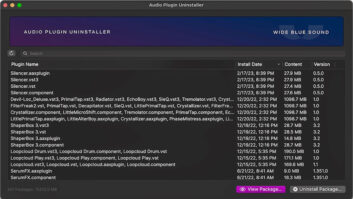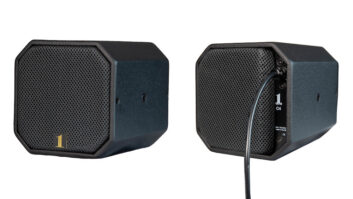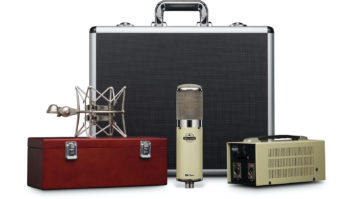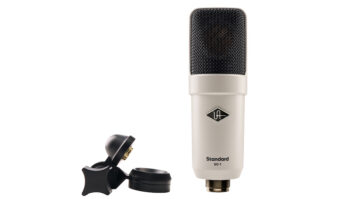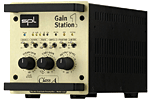
To call the SPL GainStation 1 a preamp may be a bit misleading, as this compact, single-channel unit includes two preamps — one solid-state and the other featuring a Sovtek 12AX7 LPS tube — chained in series with a dual-mode analog limiter and a DI input. The $1,199 retail unit I tested was fitted with an optional 24-bit A/D converter ($130) and Lundahl mic input transformer ($159), which together raise the list price to $1,488.
Rubber feet and large front panel handles accommodate the unit’s tabletop placement. Other options — each costing $69 — include the GainBag (which can store the preamp, a mic and cable) and a three-rackspace frame that can mount up to four GainStation 1s.
CONNECTIONS
All I/Os are on the rear panel. The XLR mic input connector can also accept balanced line signals up to +17 dBu. A ¼-inch phone jack accepts either high-impedance instrument or unbalanced line input. (I wish this jack was located on the front panel for more convenient DI access.) The input impedance for DI applications is more than 1 megohm. Redundant analog outs — one ¼-inch TRS jack (providing plug-and-play operation for both balanced and unbalanced connections) and one XLR connector — are wired in parallel before the optional A/D.
With the Model 2376 24-bit A/D option installed, the rear panel sports optical and coaxial S/PDIF outputs. The A/D’s dynamic range is 106 dB. In lieu of providing a word clock input jack, the A/D option adds a coaxial S/PDIF input for sync to external digital clock. However, the provided sync-lock status LED is inconveniently located on the unit’s rear panel.
Other A/D-related features include sampling rate selector switches (which select any nominal rate between 44.1 and 96 kHz) and a mono TRS jack labeled “AD In 2.” The latter can accept an analog input signal (+12dBu maximum level) and route it to the right channel of the optional A/D, in which case, the GainStation 1’s processed mic input signal goes to only the left S/PDIF channel and not to both channels. One application is to use the GainStation 1’s analog output(s) to feed an external processor and the AD In 2 jack as an insert receive jack for the processed signal.
ON THE FACE
On the front panel, a continuously variable rotary gain control provides from 10 to 63 dB of solid-state, Class-A gain (17 to 70 dB with the Lundahl transformer option). Another rotary gain control (this one detented) provides an additional 1 to 26 dB of tube preamp gain. This gain stage is in series with, and downstream of, the solid-state preamp, but can be bypassed by a relay. A switchable, passive highpass filter, fixed at 50 Hz, filters the solid-state preamp section with a 12dB/octave slope. Other front panel switches include mic/hi-Z input selector, polarity reversal, mic input impedance selector (with alternate 200/1.2k/10k-ohm settings), 48V phantom power (providing a whopping 14ma maximum current) and three-way limiter mode selector (with alternate Peak, +FET and “off” settings).
The Peak position activates a peak limiter that saturates the signal. When the tube preamp stage is active and the +FET position is selected, a compressor-like FET limiting stage is added before the peak limiter. The limiter’s threshold is fixed at +20 dBu, and there are no controls for adjusting time constants or ratio. A Limit LED increases in brightness in proportion to the amount of gain reduction. A detented rotary output level control provides as much as 26dB attenuation or up to +6 dB additional gain after the limiter and before the unit’s analog outputs and optional A/D.
The GainStation 1’s metering comprises a four-segment LED meter and clip LED for the solid-state preamp stage only and an overload indicator for the optional A/D.
IN THE STUDIO
Recording acoustic guitar using only the GainStation 1’s solid-state preamp and a DPA 4011 mic, the track sounded gorgeous. (The GainStation 1’s tube preamp and limiter were bypassed for this test.) Highs were sparkly and detailed, mids smooth and open and the bottom end tight. On male lead vocals recorded with a Lawson L251 tube mic, the GainStation 1 sounded wonderfully rich and sweet. Here, I used more tube preamp gain than solid-state.
On electric guitar — played through a Roland Micro Cube amp and miked with a Royer R-122 — the GainStation 1 sounded at once warm, present and chunky. The peak and FET limiter modes sounded good, but the limiter’s threshold was a bit too high for my liking. I routinely had to apply excessive preamp gain and then attenuate the post-limiter output to trigger dynamics processing yet keep the A/D from clipping.
Recording electric bass via the GainStation 1’s hi-Z input and using the unit’s peak limiter, the sound was bursting with growly overtones. Boasting a big bottom end and beautifully defined pitch, the track sounded huge.
FINAL IMPRESSION
The GainStation 1’s solid-state and tube preamps sound very different from one another, empowering the user to sculpt a variety of hybrid tones. Combine that with the unit’s insane amount of gain (more than 100 dB with the optional Lundahl transformer installed) and generous allotment of bells and whistles, and you’ve got a winner!
SPL USA, 866/4-SPLUSA, www.spl-usa.com.



